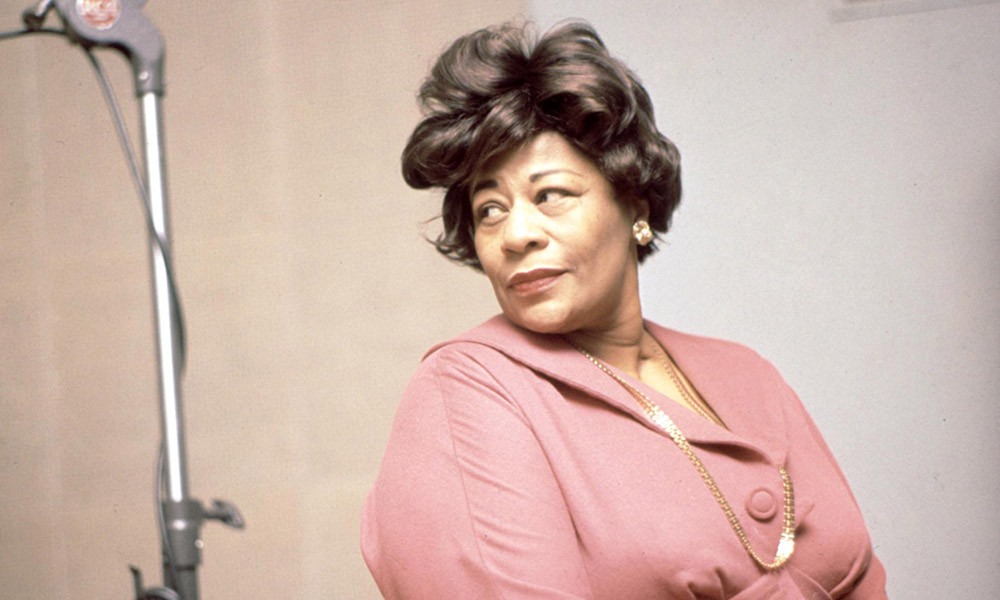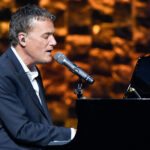Ella Fitzgerald, affectionately known as the “First Lady of Song” and the “Queen of Jazz,” remains an icon whose voice continues to captivate audiences decades after her prime. From her humble beginnings as a 17-year-old orphan winning Amateur Night at the Apollo Theater, Ella Fitzgerald ascended to global stardom, leaving behind a rich legacy of timeless music. Her journey from Harlem’s dance halls to the world’s most prestigious stages is a testament to her unparalleled talent and enduring appeal. This article explores some of Ella Fitzgerald’s popular songs, highlighting the key moments and musical masterpieces that solidified her place in music history.
 Ella Fitzgerald performing, showcasing her vocal talent and stage presence
Ella Fitzgerald performing, showcasing her vocal talent and stage presence
Her initial foray into the music scene began in 1934 when young Ella, initially aiming for a dance career, found herself singing on the Apollo Theater stage. Intimidated by a previous tap dance act, she opted to sing “Judy” and “The Object of My Affection,” a decision that changed her life forever. Winning the top prize that night was just the beginning for the prodigious vocalist.
Within a year, Ella Fitzgerald’s powerful and versatile voice landed her a spot with Chick Webb’s orchestra. This was a pivotal moment, placing her at the heart of the vibrant swing jazz era. Her voice became the velvet thread weaving through the energetic rhythms of dance halls like Harlem’s Savoy Ballroom. By 1938, the world began to truly take notice with her innovative rendition of the nursery rhyme “A-Tisket A-Tasket.” This wasn’t just a children’s tune; Ella transformed it into a swing sensation, showcasing her unique ability to infuse warmth and sophistication into any melody. Her voice, described as amber and warm with a distinctive vibrato, effortlessly traversed various musical landscapes, from lively dance numbers to soulful ballads.
Ella’s collaborations read like a who’s who of jazz legends, including Benny Goodman and Count Basie, further cementing her status in the genre. She became renowned for her interpretations of the Great American Songbook, bringing new life to classics by Irving Berlin, George and Ira Gershwin, and Duke Ellington. These renditions became definitive versions, demonstrating her profound musicality and interpretive genius.
Early Hits and Breakthrough Moments
Ella Fitzgerald’s early recordings are a vibrant tapestry of youthful energy and burgeoning talent. Her first credited recording, 1935’s “I’ll Chase the Blues Away” with the Chick Webb Orchestra, is a joyful and flirtatious introduction to her artistry. However, it was “A-Tisket, A-Tasket” in 1938 that catapulted her into mainstream fame.
A-Tisket, A-Tasket – Ella Fitzgerald’s early hit that showcased her ability to transform simple melodies into swing masterpieces
This playful yet sophisticated take on a children’s rhyme resonated with audiences nationwide. Its danceable beat and Ella’s charming delivery made it a crossover hit, proving her appeal extended beyond traditional jazz circles. The song’s success led to her onscreen debut in Abbott & Costello’s 1942 film, Ride ‘Em Cowboy, further amplifying her popularity.
Following Chick Webb’s passing in 1939, Ella took on the mantle of bandleader, demonstrating her leadership and continued musical prowess until 1942. Her collaborations during this period further expanded her reach. “T’Ain’t What You Do (It’s the Way That You Do It),” with Harry James and James Lunceford, showcased her ability to blend playfulness with infectious rhythms, reaching No. 19 on the charts. Her duet with The Ink Spots and Bill Kenny, “Into Each Life Some Rain Must Fall,” marked her first chart-topping hit, revealing her versatility and emotional depth. Another notable collaboration was with Louis Jordan, particularly their duet “Baby, It’s Cold Outside,” which highlighted her ability to engage in playful vocal exchanges.
The Scat Singing Virtuoso
No discussion of Ella Fitzgerald’s popular songs is complete without acknowledging her unparalleled scat singing abilities. She was not just a great scat singer; she was a revolutionary, pushing the boundaries of vocal improvisation in jazz. Legend has it that the term “bebop” itself originated from one of her improvisational scat sessions.
Her 1956 album Lullabies of Birdland is a masterclass in scat. Tracks like “Flying Home” are propelled by her breathtaking vocal runs, turning chord progressions into exhilarating sonic landscapes. “Oh, Lady Be Good” showcases her effortless scatting over Benny Goodman’s lively band, a testament to her improvisational genius. “How High the Moon” is another stellar example of her scat prowess. However, “Airmail Special,” particularly live versions like the one from the 1957 Newport Jazz Festival, stands as a monumental achievement, transforming the song into a euphoric, ecstatic experience.
Ella Fitzgerald scatting, demonstrating her incredible vocal control and improvisational skills
Chart-Topping Hits and Enduring Classics
As Ella Fitzgerald’s career blossomed, so did her artistic range, leading to some of her most popular and enduring songs. “Satin Doll,” her 1953 interpretation of Duke Ellington’s standard, exemplifies her ability to convey profound emotion with subtlety. Accompanied by a restrained band, her wordless vocalizations speak volumes, demonstrating her mastery of melody and phrasing.
“Mack the Knife,” originally a hit for Bobby Darin, became synonymous with Ella Fitzgerald after her spontaneous performance in Berlin in 1960. Forgetting the lyrics, she improvised new ones, turning a potential mishap into a Grammy-winning moment. This live rendition is a testament to her quick wit, improvisational brilliance, and sheer stage presence.
Ella Fitzgerald performing “Mack the Knife” live in Berlin, a testament to her improvisational genius
“Cry Me A River,” although penned for Ella by Arthur Hamilton but not originally recorded by her until later, became a signature torch song in her repertoire. Her rendition is imbued with raw emotion and dramatic intensity, making it a definitive version of this classic ballad. “Blue Skies,” with its big band arrangement and Ella’s effervescent scatting, perfectly encapsulates Ella in her prime – joyful, virtuosic, and utterly captivating. Every vocal embellishment and improvisation makes the song unmistakably hers.
The American Songbook Legacy
Ella Fitzgerald’s contribution to preserving and popularizing the Great American Songbook is immeasurable. Her series of Songbook albums, launched in the mid-1950s on Verve Records under the guidance of Norman Granz, revitalized the works of Jerome Kern, the Gershwins, Cole Porter, Irving Berlin, and Rodgers & Hart for a new generation. These weren’t mere covers; they were reinterpretations that infused these timeless songs with Ella’s unique jazz sensibility and vocal brilliance.
Ella Fitzgerald recording the American Songbook series, a landmark achievement in music history
Tracks like the Broadway-infused “I Got Rhythm” and the swingingly sophisticated “Puttin’ on the Ritz” became instant classics in Ella’s hands, captivating audiences with their verve and charm. The success of these albums owes much to the brilliant arrangers like Nelson Riddle, who masterfully framed Ella’s vocals within lush orchestral settings.
Her ballad interpretations from the Songbooks are equally compelling. Rodgers & Hart’s “Bewitched, Bothered and Bewildered” is transformed into a slow-dance dreamscape, filled with palpable longing and nuanced emotion. George Gershwin’s “Someone to Watch Over Me,” particularly her recording with the London Symphony Orchestra at Abbey Road Studios, becomes an even more poignant and timeless masterpiece in Ella’s rendition. Her Songbook albums redefined these standards, solidifying her legacy and earning her two Grammy Awards in 1958.
Duets with Louis Armstrong: A Vocal Partnership for the Ages
Ella Fitzgerald’s collaborations with Louis Armstrong are legendary, showcasing a unique vocal chemistry that continues to enchant listeners. Supported by the Oscar Peterson Quartet, and often featuring Herb Ellis and Buddy Rich, their albums are a celebration of contrasting yet complementary vocal styles. Their first album, 1956’s Ella and Louis, featured sublime interpretations of the Gershwins’ “They Can’t Take That Away From Me” and Irving Berlin’s “Cheek to Cheek.”
Ella Fitzgerald and Louis Armstrong performing together, a legendary duo in jazz history
Their musical dialogue is captivating, with Armstrong’s warm trumpet often acting as a brassy counterpoint to Ella’s mesmerizing vocals, even when he isn’t singing. They released two more albums together: 1957’s Ella and Louis Again, featuring their romantic rendition of “Autumn in New York,” and 1959’s Porgy and Bess. From Porgy and Bess, “Summertime,” the iconic melody from Gershwin’s opera, becomes a jazzy lullaby in their hands, with Ella’s impeccable diction and Armstrong’s soulful trumpet creating a truly unforgettable rendition.
Conclusion: The Enduring Legacy of Ella Fitzgerald’s Popular Songs
Ella Fitzgerald’s impact on music is undeniable. Her awards, including 13 Grammys, the Kennedy Center Medal of Honor, and the Presidential Medal of Freedom, are testaments to her extraordinary career. Preserved in the Smithsonian Institute and the Library of Congress, her work continues to inspire and influence generations of musicians and music lovers. The titles bestowed upon her – Queen of Jazz, First Lady of Song, Lady Ella – are not mere honorifics but reflections of the deep and lasting affection audiences have for her and her music. Ella Fitzgerald’s popular songs are more than just melodies; they are timeless treasures that grow richer and more resonant with each passing year, ensuring her voice will continue to enchant for generations to come.
To experience Ella Fitzgerald’s unparalleled artistry, explore albums like The Lost Berlin Tapes, which captures her live performance in 1962, showcasing her at the peak of her powers. Discovering Ella Fitzgerald’s popular songs is embarking on a journey through the heart of jazz and the soul of a true musical legend.


